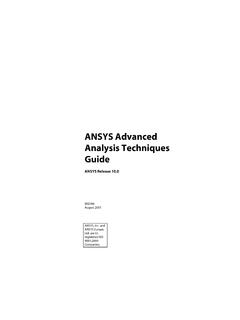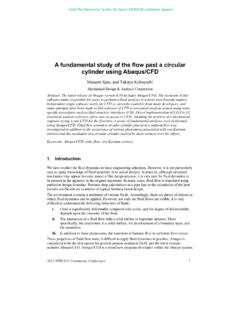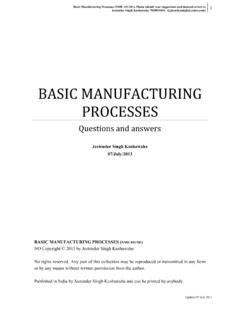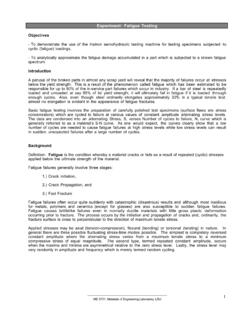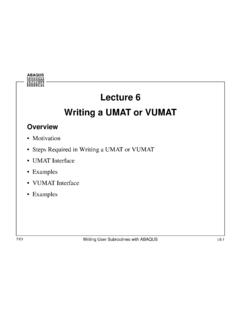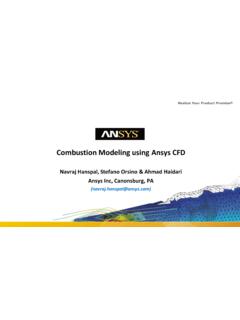Transcription of Introduction toIntroduction to ANSYS FLUENT
1 Customer Training MaterialLt 6 Lecture 6 Turbulence ModelinggIntroduction toIntroduction to ANSYS FLUENTL6-1 ANSYS , Inc. Proprietary 2010 ANSYS , Inc. All rights 2010 Introduction to ANSYS FLUENTC ustomer Training MaterialIntroduction Most engineering flows are turbulent. Unlike everything else we have discussed on this course, turbulence is essentially a random process. Therefore we cannot perfectly represent the effects of turbulence in the CFD simulation. Instead we need a Turbulence Model. The turbulence model is exactly that, a model. There is no one size fits all answer to turbulence modelling.
2 You need to pick the most appropriate tool for your simulationfor your , Inc. Proprietary 2010 ANSYS , Inc. All rights 2010 Introduction to ANSYS FLUENTC ustomer Training MaterialTurbulent Flow Structures Although random , there are patterns to the motion as eddies dissipateSmallStructuresLargeStructuresI njectionof energyDissipationof energyDissipating eddiesLarge-scale eddiesFlux of energyL6-3 ANSYS , Inc. Proprietary 2010 ANSYS , Inc. All rights 2010 Energy Cascade (after Richardson, 1922) Introduction to ANSYS FLUENTC ustomer Training MaterialBackward Facing Step As engineers, in most cases we do not actually need to see an exact snapshot of the velocity at a particular instant.
3 Instead for most problems, knowing the time-averaged velocity (and Instantaneous velocity contoursintensity of the turbulent fluctuations) is all we need to know. This gives us a useful way to approach modelling velocity contours Time-averaged velocity contours L6-4 ANSYS , Inc. Proprietary 2010 ANSYS , Inc. All rights 2010 Introduction to ANSYS FLUENTC ustomer Training MaterialIs the Flow Turbulent?External Flowsalong a surfacewheregaround an obstacleOther factors such as free-stream turbulence surfaceetc.,,,hddxL=Internal Flowsstream turbulence, surface conditions, blowing, suction, and other disturbances etc.
4 May cause transition to turbulence at Natural Convectionlower Reynolds numberswhere(Rayleigh number)L6-5 ANSYS , Inc. Proprietary 2010 ANSYS , Inc. All rights 2010(Prandtl number) Introduction to ANSYS FLUENTC ustomer Training MaterialMean and Instantaneous Velocities If we recorded the velocity at a particular point in the real (turbulent) fluid flow, the instantaneous velocity (U) would look like this:u Fluctuating velocityTime-average of velocityVelocityUVU Instantaneous velocity At any point in time: The time average of the fluctuating velocity must be zero:uUU +=0= uu BUT, the RMS of is not necessarily zero: Note you will hear reference to the turbulence energy, k.
5 This is the sum of u 02 u 222L6-6 ANSYS , Inc. Proprietary 2010 ANSYS , Inc. All rights 2010the 3 fluctuating velocity components: + + = to ANSYS FLUENTC ustomer Training MaterialApproaches to Turbulence Modelling Direct Numerical Simulation (DNS). Not In FLUENT It is technically possible to resolve every fluctuating motion in the flow. However the grid must be very fine, and the timestep very small. These demands increase with the Reynolds number These demands increase with the Reynolds number. The reality is that this is only a research tool for lower Reynolds-number flows restricted to supercomputer applications.
6 Reynolds-Averaged Navier Stokes (RANS) - In FLUENT This is the main tool used by engineers. Equations are solved for time-averaged flow behaviour and the magnitude of t rb lent fl ct ationsturbulent fluctuations. Large Eddy Simulation (LES) - In FLUENT In terms of computational demand LES lies between DNS and RANSIn terms of computational demand LES lies between DNS and RANS. Like DNS, a 3D simulation is performed over many timesteps. However only the larger eddies are resolved. The grid can be coarser and timesteps larger than DNS because the smaller fl idtit d bbidl (SGS)d lL6-7 ANSYS , Inc.
7 Proprietary 2010 ANSYS , Inc. All rights 2010fluid motions are represented by a sub-grid-scale (SGS) to ANSYS FLUENTC ustomer Training MaterialRANS Equations and the Closure Problem The time-averaging is defined as The instantaneous field is defined as the sum of the mean and the fluctuating component, such as By averaging the Navier-Stokes equations, we obtain the Reynolds averaged Navier-Stokes (RANS) equations:Reynolds stress tensor, RijL6-8 ANSYS , Inc. Proprietary 2010 ANSYS , Inc. All rights 2010 Introduction to ANSYS FLUENTC ustomer Training MaterialRANS Models RANS Models fall into one of two categories.
8 The difference in these is how the Reynolds Stress term on the previous slide is calculated:Eddy viscosity models(EVM)jiuu Eddy viscosity models(EVM). These assume the stress is proportional to the strain (strain being the gradients of velocity). The only new (unknown) quantity needed by EVMs is an effective turbulent viscosity viscosity Reynolds Stress Models(RSM): It is possible to derive a transport equation for the Reynolds Stress termsIt is possible to derive a transport equation for the Reynolds Stress terms. The model is more complex, since there are more equations to solve Indeed there are further unknowns, which themselves require a model.
9 However they make the important step in allowing the Reynolds L6-9 ANSYS , Inc. Proprietary 2010 ANSYS , Inc. All rights 2010yppgystresses to be anisotropic (the magnitude of can vary in the different directions). In some flows this is of crucial Introduction to ANSYS FLUENTC ustomer Training MaterialRANS Models - Eddy Viscosity Eddy viscosity is similar to molecular viscosity in its effect of diffusing momentum. Eddy viscosity is NOT a fluid property; it is a turbulent flow characteristic. Unlike an isothermal laminar flow in which viscosity is a constant which varies withan isothermal laminar flow in which viscosity is a constant which varies with position throughout the flow field EVMs are the most widely used turbulence models for CFD.
10 Some known limitations of the eddy viscosity concept: Isotropy assumption is built in; however, there are many flows in which the Reynolds stresses are highly anisotropic (flows with large streamline curvature impingement andstresses are highly anisotropic (flows with large streamline curvature, impingement, and highly swirling flows, etc.). Eddy viscosity models do not include dependence of the Reynolds stresses on the rate of rotation of the assumption that Reynolds stress scales with the strain-rate tensor of the mean The assumption that Reynolds stress scales with the strain-rate tensor of the mean velocity is not always , Inc.)

